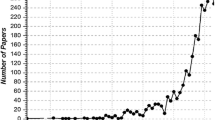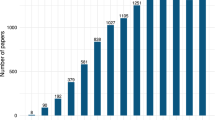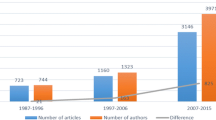Abstract
In recent years, collaborations between scholars have drastically increased in all fields. Using individual and country collaboration data from the past 30 years, this paper studies the evolution and trend of collaboration networks in the field of information systems. Our research shows that individual scholars and all countries display the “long tail” phenomenon in article publishing. Average collaboration degree and co-authorship ratio of articles over time are on the rise overall. Evolutionary analysis of collaboration networks manifest that the network development is basically mature although it has not yet reached a stable status. International collaborations have shown a gradual increase, with the increase in participating countries distributed mainly in Europe and Asia and increase in collaborations mainly in North America and Europe, especially the United States, England and Canada.











Similar content being viewed by others
References
Abbasi, A., & Altmann, J. (2011). On the correlation between research performance and social network analysis measures applied to research collaboration networks. In Paper presented at the The 44th Hawaii international conference on system science (HICSS-44), Hawaii, USA, Jan 4–7.
Abbasi, A., Altmann, J., & Hossain, L. (2011a). Idefying the effects of co-authorship networks on the performance of scholars. Journal of Informetrics, 5(4), 594–607.
Abbasi, A., Altmann, J., & Hwang, J. (2010). Evaluating scholars based on their academic collaboration activities: two indices, the RC-index and the CC-index, for quantifying collaboration activities of researchers and scientific communities. Scientometrics, 83(1), 1–13.
Abbasi, A., Hossain, L., & Leydesdorff, L. (2012). Betweenness centrality as a driver of preferential attachment in the evolution of research collaboration networks. Journal of Informetrics, 6(3), 403–412.
Abbasi, A., Hossain, L., Uddin, S., & Rasmussen, K. J. R. (2011b). Evolutionary dynamic of scientific collaboration networks: Multi-level and cross-time analysis. Scientometrics, 89(2), 687–710.
Barabási, A. L., Jeong, H., Néda, Z., Ravasz, E., Schubert, A., & Vicsek, T. (2002). Evolution of the Social Network of scientific collaborations. Physica A: Statistical Mechanics and its Applications, 311(3), 590–614.
Bertsimas, D., Brynjolfsson, E., Reichman, S., & Silberhoz, J. (2013). Network analysis for predicting academic impact. In Paper presented at the thirty fourth international conference on information systems (ICIS), Milan.
Burgoyne, J. G., Burgoyne, J., & Reynolds, M. (1997). Management learning: Integrating perspectives in theory and practice. Thousand Oaks: Sage.
Dorogovtsev, S. N., & Mendes, J. F. F. (2002). Evolution of networks. Advances in Physics, 51(4), 1079–1187.
Gallivan, M. J., & Benbunan-Fich, R. (2007). Analyzing IS research productivity: an inclusive approach to global IS scholarship. European Journal of Information Systems, 16(1), 36–53.
Guo, S. Y., Xiang, X. J., Zhu, Q., & Jiang, Q. Y. (2011). Major problems and countermeasures effecting the scientific of college evaluation index. Higher Agricultural Education, 3, 15–18.
Hodgkinson, G. P. (2001). The psychology of strategic management: Diversity and cognition revisited. International Review of Industrial and Organizational Psychology, 16, 65–120.
Jiang, Y. (2008). Locating active actors in the scientific collaboration communities based on interaction topology analyses. Scientometrics, 74(3), 471–482.
Kelemen, M., & Bansal, P. (2002). The conventions of management research and their relevance to management practice. British Journal of Management, 13(2), 97–108.
Lee, D., Goh, K. I., Kahng, B., & Kim, D. (2010). Complete trails of coauthorship network evolution. Physical Review E, 82(2), 026112.
Liu, J. (2009). The whole network analysis handout. Shanghai: Truth & Wisdom Press.
Luukkonen, T., Person, O., & Sivertsen, G. (1992). Understanding patterns of international scientific collabration. Science, Technology and Human Values, 17(1), 101–126.
Milojević, S. (2010). Modes of collaboration in modern science: Beyond power laws and preferential attachment. Journal of the American Society for Information Science and Technology, 61(7), 1410–1423.
Newman, M. E. J. (2001a). Scientific collaboration networks. II. Shortest paths, weighted networks, and centrality. Physical Review E, 64(1), 016132.
Newman, M. E. J. (2001b). Scientific collaboration networks. I. Network construction and fundamental results. Physical Review E, 64(1), 016131.
Newman, M. E. J. (2001c). The structure of scientic collaboration networks. Proceedings of the National Academy of Sciences, 98(2), 404–409.
Oh, W., Choi, J. N., & Kim, K. (2006). Coauthorship dynamics and knowledge capital: The patterns of cross-disciplinary collaboration in information systems research. Journal of Management Information Systems, 22(3), 266–292.
Owen-Smith, J., Riccaboni, M., Pammolli, F., & Powell, W. (2002). A comparison of US and European university-industry relations in the life sciences. Management Science, 48(1), 24–43.
Schubert, A. (2012). A Hirsch-type index of co-author partnership ability. Scientometrics, 91(1), 303–308.
Scott, J. (1991). Social network analysis: A handbook. London: Sage.
Sonnenwald, D. H. (2007). Scientific collaboration. Annual Review of Information Science and Technology, 41(1), 643–681.
Tranfield, D., & Starkey, K. (1998). The nature, social organization and promotion of management research: towards policy. British Journal of Management, 9(4), 341–353.
Vidgen, R., Henneberg, S., & Naudé, P. (2007). What sort of community is the European Conference on Information Systems? A social network analysis 1993–2005. European Journal of Information Systems, 16(1), 5–19.
Wagner, C. S., & Leydesdorff, L. (2005). Mapping the network of global science comparing international co-authorships from 1990 to 2000. International Journal of Technology and Globalization, 1(2), 185–208.
Wuchty, S., Jones, B. F., & Uzzi, B. (2007). The increasing dominance of teams in production of knowledge. Science, 316(5827), 1036–1039.
Xu, J., & Chau, M. (2006). The social identity of IS: analyzing the collaboration network of the ICIS conferences (1980–2005). In Paper presented at the twenty-seventh international conference on information systems, Milwaukee.
Yan, X. B., Zhai, L., & Fan, W. G. (2013). C-index: A weighted network node centrality measure for collaboration competence. Journal of Informetrics, 7(1), 223–239.
Yuan, J. P. (2010). Scientometrics advanced course. Shanghai: Science and Technology Literature Press.
Zhai, L., Yan, X., Shibchurn, J., & Song, X. (2014). Evolutionary analysis of international collaboration network of Chinese scholars in management research. Scientometrics, 98(2), 1435–1454.
Zhai, L., Yan, X., & Zhang, G. (2013). A centrality measure for communication ability in weighted network. Physica A: Statistical Mechanics and its Applications, 392(23), 6107–6117.
Zhao, S. X., Rousseau, R., & Ye, F. Y. (2011). H-Degree as a basic measure in weighted networks. Journal of Informetrics, 5(4), 668–677.
Acknowledgments
The authors of the paper sincerely appreciate the invaluable suggestions offered by the two anonymous reviewers. This work is partly supported by the National Natural Science Foundation of PRC (No. 71171067, 71328103) and Postdoctoral Science-research Developmental Foundation of Heilongjiang province (No. LBH-Q11114).
Author information
Authors and Affiliations
Corresponding author
Rights and permissions
About this article
Cite this article
Zhai, L., Li, X., Yan, X. et al. Evolutionary analysis of collaboration networks in the field of information systems. Scientometrics 101, 1657–1677 (2014). https://doi.org/10.1007/s11192-014-1360-1
Received:
Published:
Issue Date:
DOI: https://doi.org/10.1007/s11192-014-1360-1




